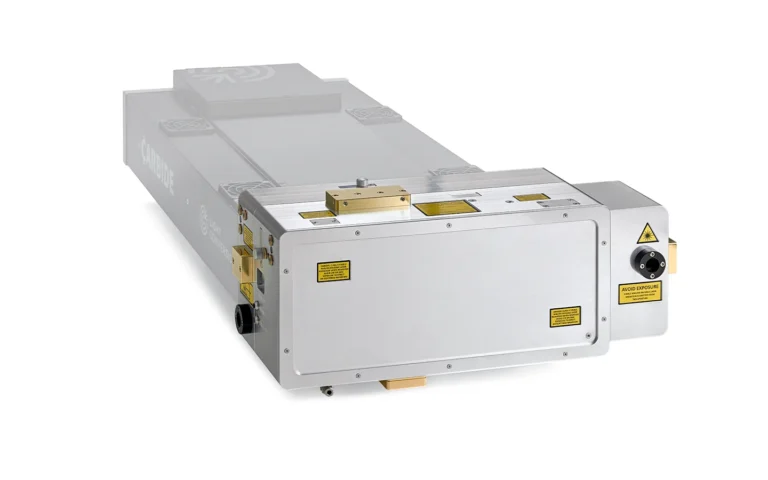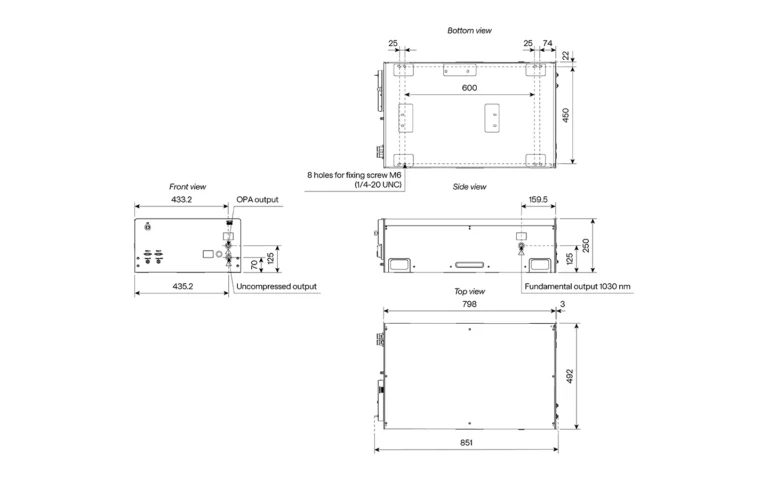The industrial-grade optical parametric amplifier I-OPA series represents a new era of simplicity and reliability in wavelength‑tunable femtosecond sources. Building on decades of expertise in optical parametric amplifiers, the I-OPA combines wavelength tunability with a robust industrial design.
Integrated seamlessly into the CARBIDE or PHAROS lasers, the rugged I-OPA offers stability comparable to industrial harmonic generators. Its sealed design provides mechanical stability and eliminates the effects of air turbulence, minimizing energy fluctuations and ensuring stable long-term performance.
The tunable I-OPA provides a wide tuning range and is primarily intended for applications in spectroscopy and microscopy:
- I-OPA-HP is optimized for coupling with HARPIA spectroscopy systems, serving as a pump beam source for ultrafast pump-probe spectroscopy.
- I-OPA-F is tailored for multiphoton microscopy.
- I-OPA-ONE is designed for IR spectroscopy and other applications requiring high-energy MIR pulses.
All models also support micromachining and various other industrial applications.
For applications requiring a single wavelength, the fixed-wavelength I-OPA offers a cost-effective and reliable solution.
| Model | I‑OPA‑HP | I‑OPA‑F | I‑OPA‑ONE |
|---|---|---|---|
| Output specifications | |||
| Configuration | ORPHEUS | ORPHEUS‑F | ORPHEUS‑ONE |
| Pump power | Up to 40 W | Up to 40 W | Up to 40 W |
| Pump power | Up to 40 W | ||
| Pump pulse energy | 20 – 400 µJ | 20 – 400 µJ | 20 – 400 µJ |
| Pump pulse energy | 20 – 400 µJ | ||
| Repetition rate | Up to 2 MHz | Up to 2 MHz | Up to 2 MHz |
| Repetition rate | Up to 2 MHz | ||
| Tuning range 1) | 640 – 1010 nm (Signal) 1050 – 2600 nm (Idler) | 650 – 920 nm (Signal) 1200 – 2500 nm (Idler) | 1350 – 2000 nm (Signal) 2100 – 4500 nm (Idler) |
| Conversion efficiency (40 – 400 μJ pump; up to 1 MHz) | > 7% @ 700 nm | > 7% @ 700 nm | > 9% @ 1550 nm |
| Conversion efficiency (40 – 400 μJ pump; up to 1 MHz) | > 7% @ 700 nm | > 9% @ 1550 nm | |
| Conversion efficiency (20 – 40 μJ pump; up to 2 MHz) | > 3.5% @ 700 nm | > 3.5% @ 700 nm | > 6% @ 1550 nm |
| Conversion efficiency (20 – 40 μJ pump; up to 2 MHz) | > 3.5% @ 700 nm | > 6% @ 1550 nm | |
| Spectral bandwidth 2) | 80 – 220 cm‑1 @ 700 – 960 nm | 200 – 1000 cm‑1 @ 650 – 920 nm 150 – 1000 cm‑1 @ 1200 – 2000 nm | 60 – 150 cm‑1 @ 1450 – 2000 nm |
| Pulse duration 2) 3) | 120 – 250 fs | < 55 fs @ 800 – 920 nm < 70 fs @ 650 – 800 nm < 100 fs @ 1200 – 2000 nm | 100 – 300 fs |
| Long-term power stability, 8 h 4) | < 1% @ 800 nm | < 1% @ 800 nm | < 1% @ 1550 nm |
| Long-term power stability, 8 h 4) | < 1% @ 800 nm | < 1% @ 1550 nm | |
| Pulse-to-pulse energy stability, 1 min 4) | < 1% @ 800 nm | < 1% @ 800 nm | < 1% @ 1550 nm |
| Pulse-to-pulse energy stability, 1 min 4) | < 1% @ 800 nm | < 1% @ 1550 nm | |
| Wavelength extension options | 320 – 505 nm (SHS) 5) 525 – 640 nm (SHI) 5) | Contact sales@lightcon.com | 4500 – 10000 nm (DFG) |
| Pulse compression options 2) | n/a | SCMP (Signal pulse compressor) ICMP (Idler pulse compressor) GDD-CMP (Compressor with GDD control) | n/a |
| Pump laser requirements | |||
| Pump laser | CARBIDE or PHAROS | CARBIDE or PHAROS | CARBIDE or PHAROS |
| Pump laser | CARBIDE or PHAROS | ||
| Center wavelength | 1030 ± 10 nm | 1030 ± 10 nm | 1030 ± 10 nm |
| Center wavelength | 1030 ± 10 nm | ||
| Maximum pump power | 40 W | 40 W | 40 W |
| Maximum pump power | 40 W | ||
| Maximum repetition rate | Up to 2 MHz | Up to 2 MHz | Up to 2 MHz |
| Maximum repetition rate | Up to 2 MHz | ||
| Pump pulse energy | 20 – 400 µJ | 20 – 400 µJ | 20 – 400 µJ |
| Pump pulse energy | 20 – 400 µJ | ||
| Pulse duration | 180 – 300 fs | 180 – 300 fs | 180 – 300 fs |
| Pulse duration | 180 – 300 fs | ||
| Environmental & utility requirements | |||
| Operating temperature 6) | 19 – 25 ºC (air conditioning recommended) | 19 – 25 ºC (air conditioning recommended) | 19 – 25 ºC (air conditioning recommended) |
| Operating temperature 6) | 19 – 25 ºC (air conditioning recommended) | ||
| Relative humidity 6) | 20 – 70% (non-condensing) | 20 – 70% (non-condensing) | 20 – 70% (non-condensing) |
| Relative humidity 6) | 20 – 70% (non-condensing) | ||
| Electrical requirements | n/a 7) | n/a 7) | n/a 7) |
| Electrical requirements | n/a 7) | ||
| Model | I‑OPA‑HP | I‑OPA‑F | I‑OPA‑ONE |
|---|
- In the case of a fixed wavelength (FW), a single wavelength can be selected from the Signal or Idler range. Signal may have an accessible Idler pair, and vice versa.
- I‑OPA‑F broad-bandwidth pulses are compressed externally. Typical pulse duration before compression: 120 – 250 fs, after compression: 25 – 70 fs @ 650 – 920 nm, 40 – 100 fs @ 1200 – 2000 nm.
- Output pulse duration depends on the selected wavelength and the pump laser pulse duration.
- Expressed as normalized root mean squared deviation (NRMSD).
- Conversion efficiency is 1.2% at the peak of the SH package; specified as the percentage of pump power.
- Specifications are guaranteed for a maximum temperature variation of ± 1ºC and humidity variation of ± 10%.
- I-OPA is powered by the same electrical source as the pump laser. Thus, refer to the pump laser electrical requirements.

Typical tuning curves of PHAROS with I-OPA-HP.
Pump: 40 W, 400 µJ, 100 kHz.

Typical tuning curves of PHAROS with I-OPA-F.
Pump: 40 W, 400 µJ, 100 kHz.
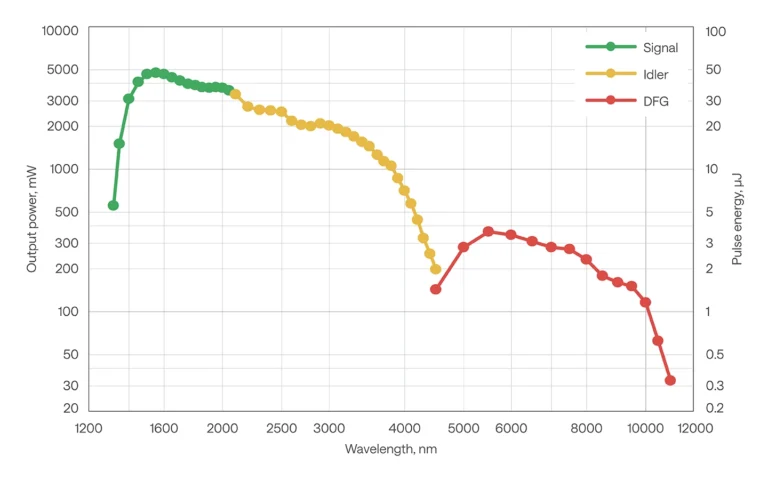
Typical tuning curves of PHAROS with I-OPA-ONE.
Pump: 40 W, 400 µJ, 100 kHz.
For custom tuning curves visit Optics ToolBox.
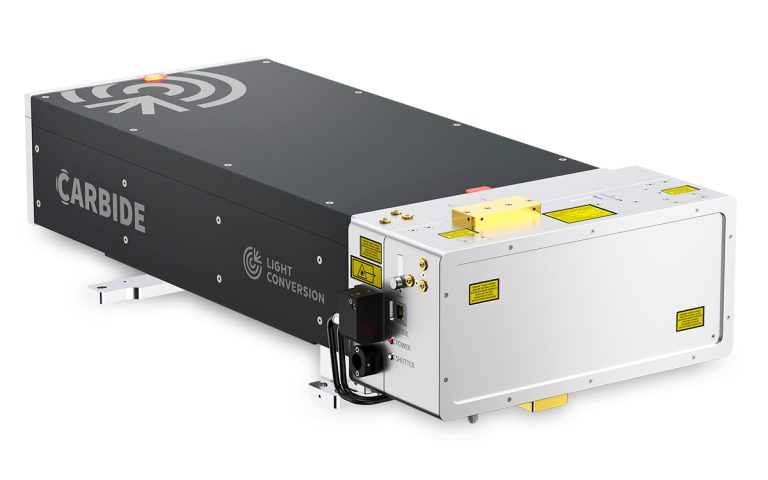
CARBIDE-CB3 femtosecond laser with I-OPA-HP.
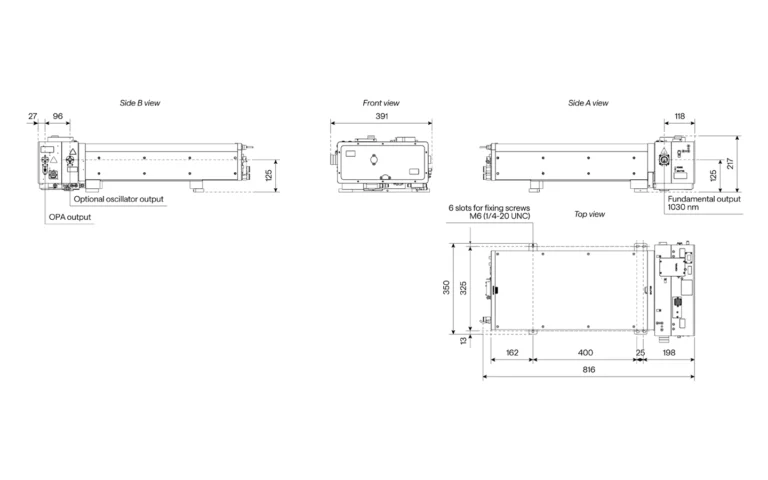
Drawing and output ports of CARBIDE-CB3 with I-OPA-HP.
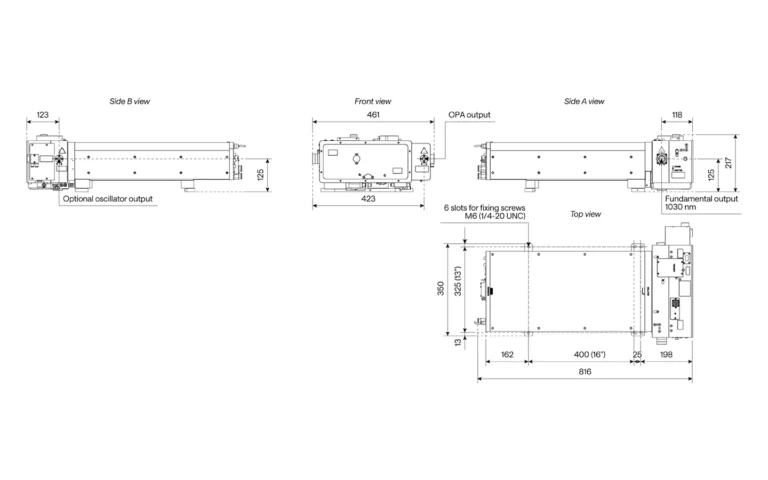
Drawing and output ports of CARBIDE-CB3 and I-OPA-HP with a SH extension.
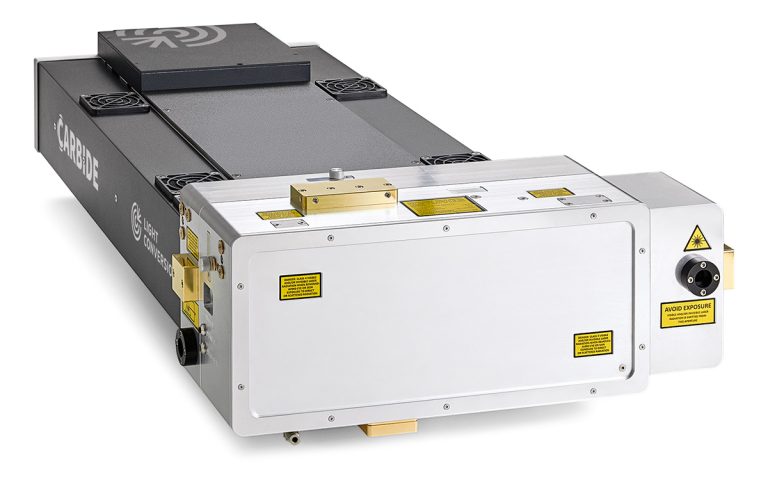
CARBIDE-CB5 and I-OPA-HP with a SH extension.
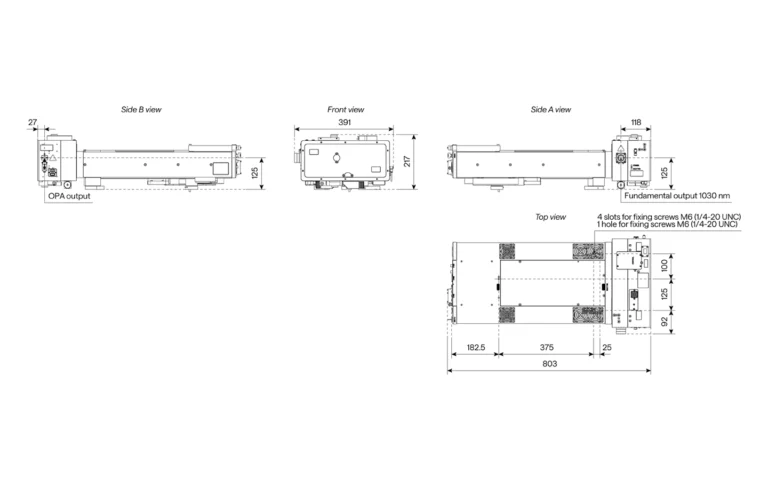
Drawing and output ports of CARBIDE-CB5 with I-OPA-HP.
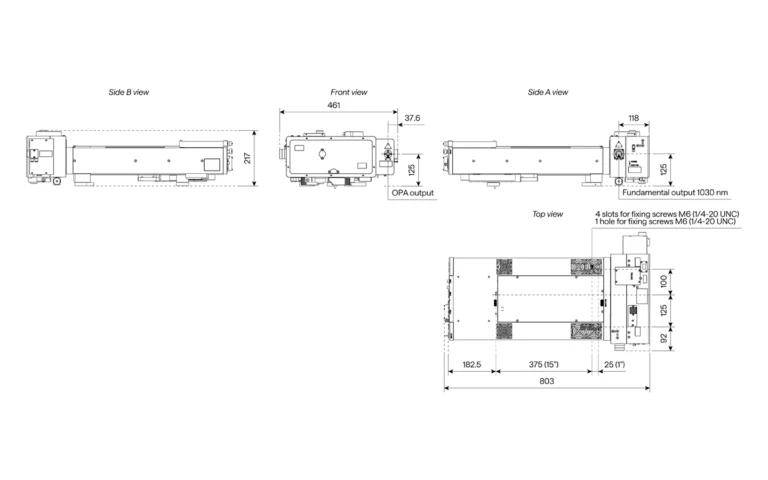
Drawing and output ports of CARBIDE-CB5 and I-OPA-HP with a SH extension.
Product datasheet
Application examples
Product catalog
Product catalog
Product catalog
Product catalog in Chinese
Product catalog in Korean
